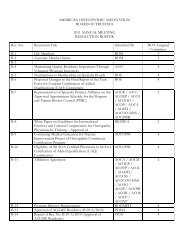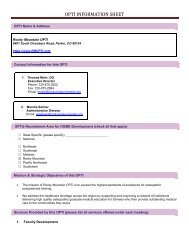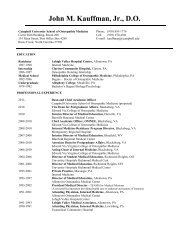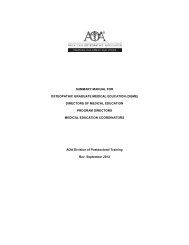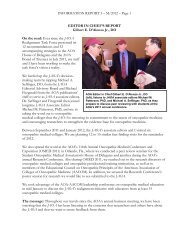Dialogue and Diagnosis - American Osteopathic Association
Dialogue and Diagnosis - American Osteopathic Association
Dialogue and Diagnosis - American Osteopathic Association
You also want an ePaper? Increase the reach of your titles
YUMPU automatically turns print PDFs into web optimized ePapers that Google loves.
T2DM is achieving glycemic control<br />
without undue risk of hypoglycemia<br />
or weight gain. A new approach<br />
would be to consider incretin-based<br />
agents, which are not associated with<br />
weight gain <strong>and</strong> which work in a<br />
glucose-dependent manner (ie, only<br />
in the presence of hyperglycemia).<br />
Basal insulin <strong>and</strong> incretin-based<br />
agents are complementary therapies<br />
for patients with T2DM—insulin corrects<br />
the basic pathophysiologic<br />
defect <strong>and</strong> incretin-based agents<br />
improve insulin secretion while<br />
decreasing glucagon output.<br />
Combining an incretin-based<br />
therapy with insulin is an attractive<br />
treatment option for Gloria. This<br />
combination has the potential to<br />
maximize glycemic control while<br />
minimizing the risk of hypoglycemia,<br />
to ameliorate the weight gain typical<br />
of insulin therapy, <strong>and</strong>—in patients<br />
on established insulin therapy—to<br />
decrease insulin dose requirements<br />
when used with a glucagon-like<br />
peptide-1 (GLP-1) receptor agonist.<br />
Insulin <strong>and</strong> DPP-4<br />
inhibitors in combination<br />
DPP-4 inhibitors are oral agents that<br />
work by inhibiting the enzyme that<br />
degrades native GLP-1 <strong>and</strong> thus<br />
support maintaining what levels of<br />
GLP-1 are still available in patients<br />
with T2DM. As such, they are associated<br />
with modest reductions in A1c,<br />
<strong>and</strong> are often used as part of combination<br />
therapy strategies, but can be<br />
used as monotherapy in patients<br />
without marked hyperglycemia.<br />
These agents, sitagliptin, saxagliptin,<br />
<strong>and</strong> linagliptin are not associated<br />
with weight gain or with nausea, <strong>and</strong><br />
are generally well tolerated.<br />
Of the DPP-4 inhibitors, sita -<br />
gliptin is currently the only agent<br />
approved for use with insulin.<br />
Although not paralleling our patient’s<br />
case directly, the TRANSITION study<br />
examined whether patients using<br />
metformin with or without other oral<br />
agents <strong>and</strong> who were not at treat -<br />
ment goals would do better with the<br />
addition of sitagliptin with or without<br />
a sulfonylurea, or sitagliptin with<br />
or without a basal insulin (insulin<br />
detemir). 22 The combination of oncedaily<br />
insulin detemir with sitagliptin<br />
showed clinically <strong>and</strong> statistically significant<br />
better improve ment in<br />
glycemic control compared to sita -<br />
gliptin with or without a sulfonylurea<br />
(P.001).<br />
Saxaglitpin also improves<br />
glycemic control in patients whose<br />
glucose levels are poorly controlled<br />
on insulin alone or on insulin <strong>and</strong><br />
metformin. A placebo-subtracted<br />
HbA 1c reduction of 0.41% was<br />
observed in a study by Barnett et al. 23<br />
When saxagliptin <strong>and</strong> other DPP-4<br />
inhibitors are used in combination<br />
with a sulfonylurea or with insulin,<br />
medications known to cause<br />
hypoglycemia, the incidence of confirmed<br />
hypoglycemia may be<br />
increased. Therefore, a lower dose of<br />
insulin secretagogue or insulin may<br />
be required to minimize the risk of<br />
hypoglycemia when used in combination<br />
with DPP-4 inhibitors.<br />
Linagliptin has not been studied<br />
in combination with insulin therapy.<br />
Insulin <strong>and</strong> GLP-1<br />
receptor agonists<br />
in combination<br />
Another option that requires subcutaneous<br />
injections—but fewer injec -<br />
tions than basal bolus insulin—<br />
include the GLP-1 receptor agonists.<br />
There are 3 currently available GLP-1<br />
receptor agonists: exenatide twice<br />
daily, liraglutide once daily, <strong>and</strong> exenatide<br />
extended release once weekly.<br />
Exenatide twice daily <strong>and</strong> liraglutide<br />
once daily are approved for use with<br />
basal insulin. The concomitant use of<br />
a GLP-1 receptor agonist <strong>and</strong> insulin<br />
may be advantageous for mitigating<br />
the weight gain associated with<br />
insulin therapy. This is particularly<br />
true for obese patients with longst<strong>and</strong>ing<br />
T2DM, as is the scenario in<br />
<strong>Dialogue</strong> <strong>and</strong> <strong>Diagnosis</strong> // September 2012<br />
27



